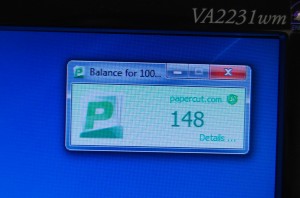Editor
 Students using the Lee Library may have noticed a green box with a number in the upper right hand corner of their computer screen, a feature of the new PaperCut program that Crowder is using. A program that is meant to help Crowder manage printing and create a more green campus.
Students using the Lee Library may have noticed a green box with a number in the upper right hand corner of their computer screen, a feature of the new PaperCut program that Crowder is using. A program that is meant to help Crowder manage printing and create a more green campus.
Before the program, “Many open labs had no control over printing,” said Chris Woitowitz, Director of Information Technology (IT). “Students were printing thousands and thousands of sheets.”
Woitowitz also mentioned how he and others noticed how students would want five or six sheets of a power point, but instead of printing only those pages, they would print the entire power point, 60 – 100 pages, for only a couple of sheets, and throw the rest away. Woitowitz said that he would find about 46 percent of a power point in the recycling bin.
PaperCut is meant not only to control printing, but to “Make students aware what they are printing and how much,” said Charity Williams, IT help desk assistant.
How PaperCut works is that each student gets a limit of how much paper that they can print, and must contact the IT help desk if they require more pages to be added to their account. “We will typically increase their quota by 100 or so depending on how far we are in the semester,” said Woitowitz. “If we have repeat students, we will start looking at their print history to determine what they are printing and why they need additional sheets.”
Originally, students were only given 500 pages; however, the IT have upped that limit to 750 pages. “We initially ran PaperCut in a ‘monitoring’ mode and found that 95 percent of the students fell below the allotted 500 sheets during the semester,” said Woitowitz. There are no limits for faculty or staff users.
In some computer labs, there are controls in place that limit how many pages a student can print in one setting.
Right now there are no charges for using the PaperCut program, but Woitowitz does not know if that will change in the future. It would be an institution decision to decide if there will be additional fees for printing beyond what is normally charged.
At the moment, PaperCut is only in effect on the Home Campus; however, by the fall of 2013, this program will be in effect on all of Crowder’s campuses.
Also, the widget that displays how many pages a student has left to print is only visible on the library’s and Academic Resource Center’s computer screens; however, the program affects all of the computer’s on the Neosho Campus, and tracts all printing that a student performs, both how many times a student prints and how many pages are printed.
“I think it has good intentions, but in the long run, it’s going to cause more harm than be helpful,” said Victoria Stafford, general studies major.
The program is also meant to help the campus and students to be more green by showing statistics of how printing effects the environment. For example, printing 793 pages of paper is equal to: 0.985 percent of a tree, 3.6 kg of carbon dioxide and equivalent to running a 60W bulb for 224.7 hours.
The PaperCut program has been designed to “Make aware” how much printing a student does, said Woitowitz. He also said, “PaperCut was not instituted as punishment, printing was an uncontrolled cost that continued to rise each semester.”
“I think it’s [PaperCut] a great idea,” said Natalie Estrada, social work major, “and see why they would put it into place, I of many students who abused the printer. But I think it hurts most hard working students, like nursing students, who need to print [a lot of] things out. Or just any hard working student who needs something physical there to help them learn like me.”

http://lestark1.wordpress.com/2013/04/29/the-crowder-sentry-papercuts-printing-on-campus/#more-339